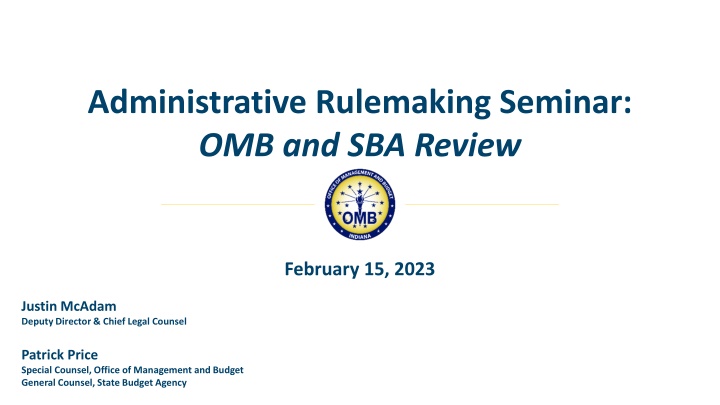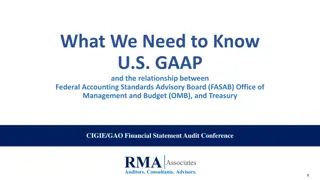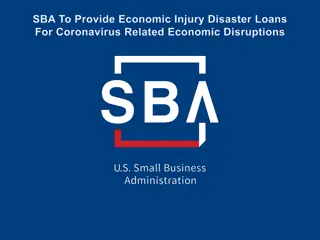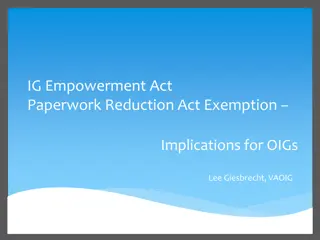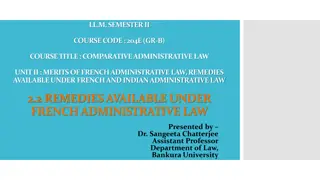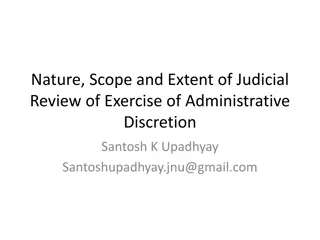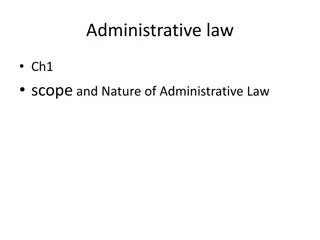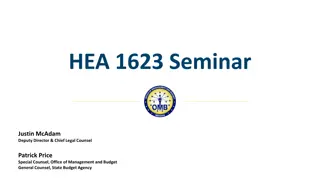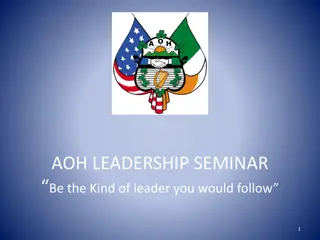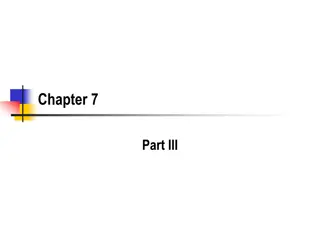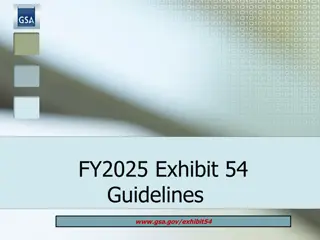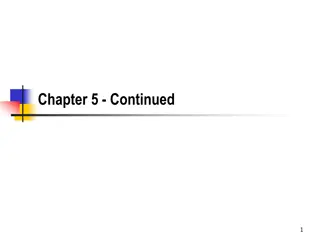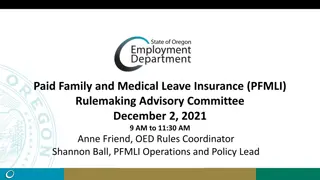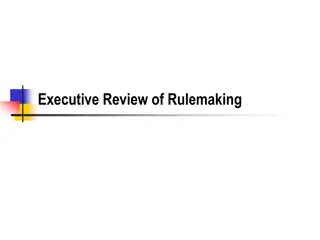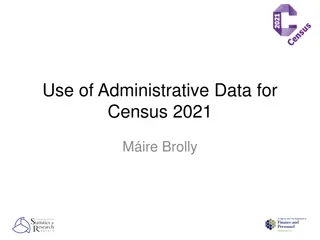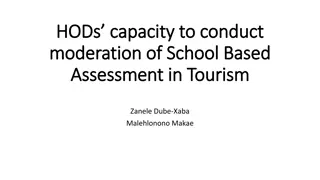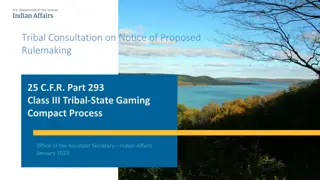OMB and SBA Review Overview at Administrative Rulemaking Seminar
Dive into the OMB and SBA review processes as it pertains to administrative rulemaking. Gain insights on the scope, key steps, and requirements involved in this critical evaluation. Understand how agencies interact with OMB to seek approval for exceptions and navigate the intricate regulatory landscape effectively.
Download Presentation

Please find below an Image/Link to download the presentation.
The content on the website is provided AS IS for your information and personal use only. It may not be sold, licensed, or shared on other websites without obtaining consent from the author.If you encounter any issues during the download, it is possible that the publisher has removed the file from their server.
You are allowed to download the files provided on this website for personal or commercial use, subject to the condition that they are used lawfully. All files are the property of their respective owners.
The content on the website is provided AS IS for your information and personal use only. It may not be sold, licensed, or shared on other websites without obtaining consent from the author.
E N D
Presentation Transcript
Administrative Rulemaking Seminar: OMB and SBA Review February 15, 2023 Justin McAdam Deputy Director & Chief Legal Counsel Patrick Price Special Counsel, Office of Management and Budget General Counsel, State Budget Agency
Roadmap of Presentation III. Cost-Benefit Analysis I. OMB / SBA Review Overview Review In Practice Tips for Smooth OMB Review Time Required for OMB Review Overview Answer the Why How to Prepare Analyses Examples from cost-benefit analyses II. General Rulemaking Requirements V. Helpful Resources What must be included in a Rule What is a Rule Role of Rules VI. Questions
OMB Review Overview Background OMB review provided in statute, IC 4-3-22-13 and IC 4-22-2-2 Prereview established by Executive Order 13-03 Financial Management Circular #5.1 (1/1/2022) defines OMB review process Purposes Coordination between agency, SBA, OMB, and Governor s Office Evaluate whether burdens imposed by regulations are justified; IC 4-3-22-1 Cost-benefit analysis
Scope of OMB Review Applies to ALL executive branch agencies (as defined by IC 4-22-2-3(a)) - any officer, board, commission, department, division, bureau, committee, or other governmental entity exercising any of the executive (including the administrative) powers of state government Does NOT APPLY to separately elected statewide offices - Attorney General - Secretary of State - Auditor of State - Treasurer of State Does NOT APPLY to judicial or legislative branches Does NOT APPLY to re-adoptions of expired rules Does NOT APPLY to emergency rules
OMB Review Process STEP 1: Agency submits exception request to OMB - Letter from agency head requesting exception - All supporting materials required by FMC #2015-1 - Send to sbarules@gov.in.gov STEP 2: OMB reviews request for completeness and assigns tracking # - OMB will send response acknowledging exception request - Agency should reference tracking number in correspondence (e.g., OMB #2019-001) - Incomplete requests will be held until all supporting documentation provided STEP 3: OMB reviews exception request - OMB will contact agency with questions and to obtain additional information if necessary
OMB Review Process (cont) STEP 4: Governor s Operations Director for agency reviews proposed rule - Allows agency to address any questions/concerns about proposed rule STEP 5: OMB issues written determination approving/denying exception request - Letter from OMB to agency will be emailed to submitter
Contents of OMB Review Request 1. Detailed summary of proposed rule described in FMC #5.1: history and background of rule justification for rule statutory authority for rule statutory authority for rule and agency promulgation description of existing legal framework governing the subject matter of rule Identification of applicable Moratorium exception(s) Fiscal Impact Analysis described in FMC #5.2 Cost-Benefit Analysis described in FMC #5.2 Draft of proposed rule Agency staff member contact info (rule/policy) 2. 3. 4. 5. 6.
SBA Review Overview Background Fiscal impact analysis required by Executive Order 2-89 Cost-benefit analysis required by IC 4-3-22-13 Financial Management Circular #5.2 (1/1/2022) defines review process Purpose SBA assessment of fiscal impact
Steps in SBA Review STEP 1: Agency submits proposed rule to OMB - All supporting materials required by FMC #2010-4 - Copy of Regulatory Moratorium exception letter - Send to sbarules@gov.in.gov STEP 2: OMB reviews request for completeness - OMB will send response acknowledging receipt - Verification that proposed rule matches rule approved at OMB Review - Incomplete requests will be held until all supporting documentation provided STEP 3: SBA Budget Analyst reviews fiscal impact analysis - SBA may contact agency with questions and to obtain additional information about fiscal impact
Steps in SBA Review (cont) STEP 4: OMB reviews proposed rule - Focus on any changes from when submitted for OMB review STEP 5: SBA reviews proposed rule - Focus on fiscal impact STEP 6: Budget Director reviews proposed rule and issues written determination approving/denying rule - Letter from SBA Director to agency will be emailed to submitter
Contents of SBA Review Request Contents of Request 1. Fiscal Impact Analysis 2. Cost-Benefit Analysis 3. Notice of Intent to Adopt Rule 4. Small Business Economic Impact Statement 5. Final Draft of Proposed Rule
OMB / SBA Review In Practice OMB Review Collaborative process between OMB, Governor s Office, and Agency Focus on rule language and cost-benefit analysis Should be completed before initiating formal rulemaking Process is deliberative and exempt from APRA (PAC opinion 17-FC-270) SBA Review Fiscal Impact and Cost-Benefit analyses required for final approval Submitted for review after agency publishes Notice of Intent Proposed rule should match rule approved by OMB review Agency should identify and explain any substantive changes
Tips for Smooth OMB Review Be prepared to talk to us about the rule Have everyone in the discussion at the same time lawyers and subject matter experts Don t bite off too much Rule only moves as fast as the slowest portion Can break off higher priority portions to move through first Don t reinvent the wheel modifying existing administrative code tends to be easier than a repeal and replace Consider hiring outside resources for big rules
Tips for Smooth Review (cont.) Identify what is new redlines changes from existing requirements) Check legal authority for each provision Feedback from interested parties Avoid duplication of statutory or CFR language (consider manuals) Include requirements from forms or policy Consider talking to OMB before drafting
Time Required for OMB Review Rules Approved 25% of rules approved in 50% of rules approved in 75% of rules approved in 57 8 days 18 days 60 days 2022 33 9 days 12 days 34 days 2021 38 27 days 53 days 91 days 2020 50 55 days 89 days 135 days 2019 34 61 days 96 days 164 days 2018
What Must be Included in a Rule? Common Questions What must be in regulation and what can be in agency policy, forms, or manuals? Why isn t the agency policy enough? Can the requirement be included in the agency form? Can the statute be repeated in the rule? The rule is not comprehensive and doesn t tell people everything they need to know. Starting Point Statute Administrative Rules and Procedures Act specifies what is considered a rule Case Law expands on this definition
What is a Rule Statute Indiana Code establishes what must be included in regulation IC 4 22 2 3(b) Rule means the whole or any part of an agency statement of general applicability that: (1) Has or is designed to have the effect of law; and (2) Implements, interprets, or prescribes: (A) Law or policy; or (B) The organization, procedure, or practice requirements of an agency.
What is a Rule Case Law Courts have adhered closely to the statutory definition Rules have Four Elements Villegas v. Silverman, 832 N.E.2d 598 (Ind. Ct. App. 2005) An administrative rule is: (1) an agency statement of general applicability to a class; (2) that is applied prospectively to the class; (3) that is applied as though it has the effect of law; and (4) that affect[s] the substantive rights of the class. Effect of Law means Mandatory Ward v. Carter, 90 N.E.3d 660 (Ind. 2018) an agency regulation carries the effect of law when it prescribes binding standards of conduct for persons subject to agency authority. [I]f an agency rule acts as a coercive mechanism or wields coercive power over people, it carries the effect of law.
Why is Policy Not Enough? Because statute requires certain process for adoption Agency power to make rules flows from General Assembly Agencies can only make rules where authorized by statute General Assembly requires rules to be adopted using certain process Administrative Rules and Procedures Act (IC 4-22-2) Requires due process (sort of) Villegas v. Silverman, 832 N.E.2d 598 (Ind. Ct. App. 2005) These requirements dictate, among other things, public input into any proposed rule changes. The duty of the BMV to issue licenses in a manner that it deems prudent does not supercede the mandate to allow the public to participate in the rule-making process.
Why is Policy Not Enough? (cont.) Courts will not enforce rules without procedural steps Agency policies without rulemaking steps do not carry the effect of law We hold that the new identification requirements are a rule, and because they were not promulgated in accordance with the ARPA, they are void and without effect. Villegas, 832 N.E.2d at 610 IDEM may only regulate by a new rule if the proper rulemaking procedures have been followed. Indiana-Kentucky Elec. Corp. v. Comm'r, Indiana Dep't of Env't Mgmt., 820 N.E.2d 771, 780 (Ind. Ct. App. 2005) Examples of rule alternatives rejected by courts: Written policy: Villegas, (required documents for driver s license) Oral policy: Indiana-Kentucky Elec. Corp., (location of environmental monitoring equipment) Contract: Am. Trucking Associations, Inc. v. City of Los Angeles, Cal., 569 U.S. 641 (2013) (imposing distinctive governmental authority through contract)
What is a Rule Examples In General Requirements that must be met need to be in statute or regulation Basis for denying application or permit must be in statute or rule Basis for violation or enforcement action must be in statute or rule Examples information required to be submitted in an application documents required to prove identification required equipment required training standards fees and fines exact amount formula - must define what you are doing and how it is calculated
Statutes vs. Rules Statutes set general program requirements Regulations fill in details Regulations can expand or explain statutory requirements and definitions Rules should not duplicate statute, IC 4-22-2-19.5(a)(3) If your rule repeats statute, must update rule each time statute is updated Means more rules and more confusion
Rules vs. Policies / Manuals Rules impose requirements Rules are legally enforceable Policies and Manuals explain requirements Manuals can combine requirements from statute and regulation and explain in regular language for regulated parties Examples, BMV Driver s Manual, DNR Hunting Manual Policies and Manuals are not legally enforceable
Example 1 BMV Statute IC 9-24-16.5-1 The bureau shall issue a photo exempt identification card to an individual who meets the following conditions (2) Is an Indiana resident. Regulation 140 IAC 7-1.1-3(b) An applicant must show proof of the following (4) Being an Indiana resident and of the applicant's residence address, which may not be a post office box, by submitting two (2) documents showing proof of being an Indiana resident and two (2) documents showing the applicant's residence address. Qualifying documents include the following BMV Driver s Manual You must be a legal resident of Indiana to obtain an Indiana credential. Evidence of Indiana residency includes: Maintaining a residential address in Indiana and not claiming residency in another state Being a registered voter in Indiana Having a dependent who is enrolled in an elementary or secondary school located in Indiana
Example 2 DNR Statute IC 14-22-11: Establishes basic requirements for hunting licenses. DNR Regulation 312 IAC 9-12-2(a): In addition to the requirements for obtaining a hunting license under IC 14-22-11, an individual born after December 31, 1986, must have successfully completed a course in hunter education by the department or the department's agent under IC 14-22-35- 1 and this rule. DNR Hunting Manual Hunter education: Anyone born after Dec. 31, 1986 must successfully complete a DNR- offered hunter education class to purchase an Indiana hunting license.
Statute, Rule, or Manual / Policy Statute Rule Policy Manual Purpose Set legal authority and basic requirements Expand on basic requirements Explain / clarify specific requirements Synthesize and explain all requirements Legally Enforceable Yes Yes No No Requirements for Adoption Set by Indiana Constitution Set by Indiana statute Set by internal agency policy Set by internal agency policy Language style LSA bill drafting manual LSA rule drafting manual Typically, legal memo style Common language Comprehensive Maybe, agency rules can supplement No, does not include statutes Usually focused on one issue Yes, one-stop summary for public
Cost-Benefit Analysis Overview WHAT Document the net impact of a new rule GOAL Justify new regulation by demonstrating that benefits exceed costs. FOCUS Minimizing negative impacts and maximizing benefits of new rule.
Cost-Benefit Analysis Statutory Requirements Minimize the expenses to regulated entities that are required to comply with the rule. IC 4-22-2-19.5 Include justification of any requirement or cost that is imposed on a regulated entity under the rule. IC 4-22-2-24 Include the total estimated economic impact. IC 4-22-2-28 Describe any assumptions made and any data used. IC 4-22-2-28
Cost-Benefit Analysis Steps Step 1: Identify each new requirement in proposed rule Step 2: Identify impacted parties Step 3: For each new requirement, identify benefits Step 4: For each new requirement, identify the costs Step 5:Aggregate the total benefits and costs for each requirement and the entire rule Step 6: Explore mitigation options Step 7: Seek input from affected on proposed rules
Identify All New Requirements Step 1: Identify everything in the proposed regulation that is changing from current requirements Must identify all changes from existing regulation Biggest reason for delays in OMB review Redlines or another way to track changes Lists or tables can be very helpful Identify any current requirements Statute, other regulations, federal regulations, court orders, compacts, etc. Can include in list, table, or annotations Excluded from cost-benefit analysis of the rule
Who Is Impacted by Changes? Step 2: Identify impacted parties Serves as the multiplier for costs / benefits Consider impact on all persons affected by the rule (not just regulated persons) Can exclude parties already in compliance from cost-benefit analysis Can determine from variety of sources Agency records Calculations Research Estimates Surveys
Example 1 Impacted Parties How to Identify Number of Impacted Parties Sometimes you know PLA: There are 60,993 beauty culture professionals, 8217 beauty culture salons, 99 beauty culture schools, and 498 tanning facilities holding active licenses in the State of Indiana. Sometimes you can calculate Egg Board: Total number of small businesses in Indiana who would be potentially impacted by the requirement for using new packaging materials is estimated to be 170 producer packers. This number was determined by the total of 540 small egg businesses minus 355 registered farm market retailers who would be exempt under the proposed rule. We then removed the 15 small wholesalers who are not packing their own eggs and would not have a direct cost associated with purchasing new packaging materials.
Example 2 Impacted Parties How to Identify Number of Impacted Parties Sometimes you can estimate IDHS: It is estimated that this proposed rule will affect somewhere around 14,068 homes per year. This is the number of homes believed to be constructed each year in Indiana, based off building permit data obtained from the United States Census Bureau. Health: Of the 54 Indiana counties responding to a survey, 50 local health departments reported that in 2020 there were a total of 4954 septic permits issued, or an average of 99.1 per local health department, and in 2021, 49 local health departments reported that there were a total of 4885 septic permits issued, representing an average of 99.5 permits per county. These were the years that the impact of COVID was most significant, and the number of permits issued may not be representative of past or future years. If this average of 99.5 permits were extended to all 92 counties in Indiana, that would give an approximate number of 9154 residential septic permits issued each year.
Benefits: Answer the Why Step 3: Identify benefits for each change What is the benefit it s the reason you are doing the rule Benefits are positive externalities of the rule Who gets the benefits usually someone other than the group regulated Benefit is usually the value in solving the problem How to calculate benefits same way you calculate costs, BUT Often benefits are less certain Can be more intangible and less concrete than costs Usually require assumptions and estimates Look to research studies (e.g., value of human life, quality adjusted life years)
Benefits: Source of Motivation How did this problem come to your attention? Inspection records Enforcement proceedings Implementation experience Consumer complaints Lawsuits Consent decrees Federal requirements Research studies Experience of other states or jurisdictions
Benefits: Motivation Examples Health: Individuals with a confirmed elevated blood lead level of 5 g/dL and above can expect increased healthcare costs and a loss in lifetime earnings. Egg Board:According to a CDC report, there were 8 cases of Salmonella in Indiana that were attributed to back yard poultry flocks. IURC: NiSource, the parent company of Columbia Gas of Massachusetts, said restoration and payment of claims related to the Merrimack Valley gas disaster could cost greater than $1 billion for that one incident. Even one smaller incident with fatalities can easily exceed tens of millions of dollars. IDEM: Persons impacted by military deployment unable to provide the necessary documentation or retake the examination within a specified amount of time. Insurance: The proposed rule is based upon Model #787 and must be adopted in each state in order for that state to maintain its accreditation with the NAIC. States failing to maintain NAIC accreditation will subject domestic insurers to financial examinations from each of the other NAIC-accredited jurisdictions.
Costs: Answer what it takes Step 4: Identify costs associated with each change What is the cost it s the burden of complying with the rule Costs are negative externalities of the rule Who bears the costs the parties regulated by the rule (and potential others who are indirectly affected) Anyone who must change their behavior to interact with the regulated party How to calculate costs same way you calculate benefits, BUT Often costs are more certain and ascertainable Can be more tangible and concrete than benefits May require assumptions and estimates, but scope of impact should be mostly evident from rule Look to surveys of regulated parties (e.g., what would it take to comply) Exclude impacts and costs of existing compliance
Example 1 Existing Compliance Existing Compliance Reduces Cost Imposed by Regulation Using Enforcement Records State Chemist: There are currently approximately 300 regulated and potentially impacted government entities in Indiana. These government entities are broken down roughly as 75% (225) local, 23% (69) state, and 2% (6) federal. Based on routine government facility inspections by OISC, it is estimated that at least 80% of these government entities already have application recordkeeping systems in place. IDHS: IDHS employs EMS District Managers who are responsible for 2-3 IDHS districts and would handle EMS organizations in roughly 20 Indiana counties. The District Manager interacts frequently with the EMS providers in their districts and also will do organization visits or official audits. All new ambulances are inspected, so every time a new ambulance is put into service the District Manager will be on site. This is how they interact and discover the equipment and resources that are being used.
Example 2 Existing Compliance Using Surveys DOC: A fiscal impact toolkit was developed to measure a detention facility s current level of compliance with the new standards, and if noncompliant, the extent of any fiscal impact to achieve compliance. All nineteen (19) juvenile detention facilities were provided the fiscal impact toolkit; of those, twelve (12) of the detention facilities completed the toolkit. A potential fiscal impact was reported for a total of nine (9) standards. Using Surveys plus internet research BMV: BMV has conducted a survey of all licensed driver education schools to determine how many vehicles this amendment would impact. Of the 80 schools that responded, five vehicles total were reported to not already have this safety feature in place. Assuming a replacement cost of $13.99 for the mirror (determined via internet research), the anticipated cost to all licensed entities is approximately $70.
Add It All Up Step 5: Tally costs and benefits for each new requirement and aggregate for the entire rule For each new requirement, sum the benefits and costs Multiply average costs / benefits by number of impacted parties Exclude parties already in compliance from cost-benefit analysis Evaluate the net benefit for each requirement separately Benefits from one requirement cannot offset costs of another Aggregate the calculation for each requirement to determine the total net benefit of rule Consider using a table
Example Tallying Costs Number of impacted parties x Cost imposed Existing compliance PLA: Dry needling courses are typically three days and include 27 to 29 hours of instruction. The estimated cost for a Physical Therapist to take two courses is $1,300 to $2,000, not including travel or lodging. Based on a survey that was sent to over 40 leaders of hospital physical therapy departments and physical therapy private practices across the state, approximately 239 licensed Physical Therapist have already completed 1 dry needling course and approximately 76 license Physical Therapist have completed 2 or more dry needling courses. The estimated cost for a Physical Therapist who has already taken one course would be $600 to $1,000, not including travel or lodging, and Physical Therapists who have already completed 2 or more dry needling courses may not require any additional training. The total estimated cost for existing Physical Therapists who have taken at least one dry needling course to meet the new standard is $239,000.
Ex. 1 Weighing Costs and Benefits Quantify the overall benefits of the regulation Health: Individuals with a confirmed elevated blood lead level of 5 g/dL and above can expect increased healthcare costs and a loss in lifetime earnings. A Columbia Law School review of one cohort of 1- and 2-year-olds in Texas in 2014 estimated that the per child societal costs of children with blood lead levels more than 5 g/dL was $10,813. This includes costs associated with immediate medical intervention, lead related ADHD, parental time-off work, special education costs, and lost earning potential. It does not include pain and suffering, future-related adult medical expenses, or criminal justice costs. In Indiana, using the same conservative assumed per-child savings, Hoosiers would see avoided costs of $20.9M in for those children above 5 g/dL in year one.
Ex. 1 Weighing Costs and Benefits Quantify the overall costs of the regulation Health: The Indiana Department of Health expects the reduction in the EBLL threshold to cost $6,599,894 in year one and $10,225,222 in year two. Costs will grow in years 3-5 with the additional children tested under universal screening, but will taper down in years 6-10 as the state moves to a targeted screening strategy. In total, this rule change, coupled with the new universal screening legislation, will cost $119,421,978 over a ten-year period.
Ex. 2 Weighing Costs and Benefits Quantify the Overall Benefits of the Regulation Egg Board: Consumer safety The majority of our 170 businesses who may reuse egg cartons are from small back yard flocks of 250 birds or less. According to a report from the Centers for Disease Control, there were 8 cases of Salmonella in Indiana that were attributed to back yard poultry flocks. Nationally, 2017 saw the largest increase in the incidence of Salmonella in humans as a result of live poultry. Product traceability When egg cartons are reused there is an increased probability that the trace back information required on every egg carton can be incorrect or conflicting when multiple sets of information are present. In the event of a food borne illness contributed to egg consumption occurs, the accurate and rapid trace back to the origin is vital. Using only new cartons at retail will alleviate the potential to trace back to multiple origins and save significant resources.
Ex. 2 Weighing Costs and Benefits Quantify the Overall Costs of the Regulation Egg Board: As of March 31, 2018, we have 139 registrants in this classification. Each of these registrants is required to report the volume of eggs they distribute. This information indicates that, on average, this group of producer retailers is distributing approximately 145,000 dozen eggs per year. Assumptions for calculating annual impact: All eggs are marketed in 1 dozen egg cartons New egg carton cost was calculated from an average of 3 on-line suppliers Egg cartons are foam material, purchased in 100 carton packages The average price per carton = $.42. The 145,000 dozen distributed by small businesses with a carton cost of $.42 would result in a total annual economic impact of $60,900 in increased cost, if all eggs were currently being marketed in used cartons. Average annual per business cost is calculated to be $438.13. Range from ($0 - $2500 (all eggs retailed from a 250-bird flock)).
Example Summarizing Net Benefits Tables Can Be Helpful to Summarize Percent existing compliance Impacted Parties Average Benefit Average Cost Total Benefit Requirement Total Cost Net Benefit Comments Existing compliance estimated from industry survey 1,000 $400 $50 46% $184,000 Requirement 1 $23,000 $161,000 Going to consider mitigation options to reduce costs 1,000 $200 $150 Requirement 2 25% $150,000 $112,500 $37,500 National standard has been in place since 2020 and enforcement records indicate almost complete voluntary compliance already Requirement 3 1,000 $10 $2 99% $100 $20 $80
Attempt to Reduce Costs Step 6: Explore mitigation options to reduce costs Even when regulation has net benefit, always explore ways to reduce costs Common techniques include: Grandfathering Delayed enforcement Exceptions Safe Harbors Making it easier to comply Transition assistance OMB happy to assist with brainstorming mitigation options
Example 1 Minimizing Costs Commonly used techniques to minimize costs imposed Grandfathering Health: (i) This rule does not require existing onsite sewage systems to comply with updates made to this rule subsequent to the system s installation, except to the extent necessary to fix a malfunction or failure. Safe Harbor DNR: (i) A person who possesses or sells a boreal chorus frog that was lawfully acquired by the person does not violate this section if the person does each of the following: (1) Lists the number of boreal chorus frogs in possession on a departmental form by October 1, 2021. (2) Identifies the frog with an individually unique elastomer or another method of permanent marking approved by the director. (3) Manages the frog in a manner that is likely to ensure the safety of the public and the health of the frog.
Example 2 Minimizing Costs Delayed Enforcement DNR: Effective October 1, 2021, snare lock" means a device that creates and maintains a snare loop and prevents the loop after closure upon an animal from reopening to a diameter that allows the animal to escape. (regulation filed November 2020) DNR: a person must not: (1) sell, offer or grow for sale, gift, barter, exchange, or distribute a species; (2) transport or transfer a species; or (3) introduce a species. Subdivisions (1) and (2) are effective one (1) year after the effective date of this section.
Example 3 Minimizing Costs Making it Easier for Regulated Parties to Comply DNR: (b) In order to be effective, a zone established under this rule must be identified by coordinates or on-site by buoys placed under 312 IAC 5-4. Changed to: (b) In order to be effective, a zone established under this rule must be identified with signage at the coordinates or on-site by buoys placed under 312 IAC 5-4. Consider human behavior Try to harness human behavior and work with it, not against it Cass Sunstein and Richard Thaler s Nudge
